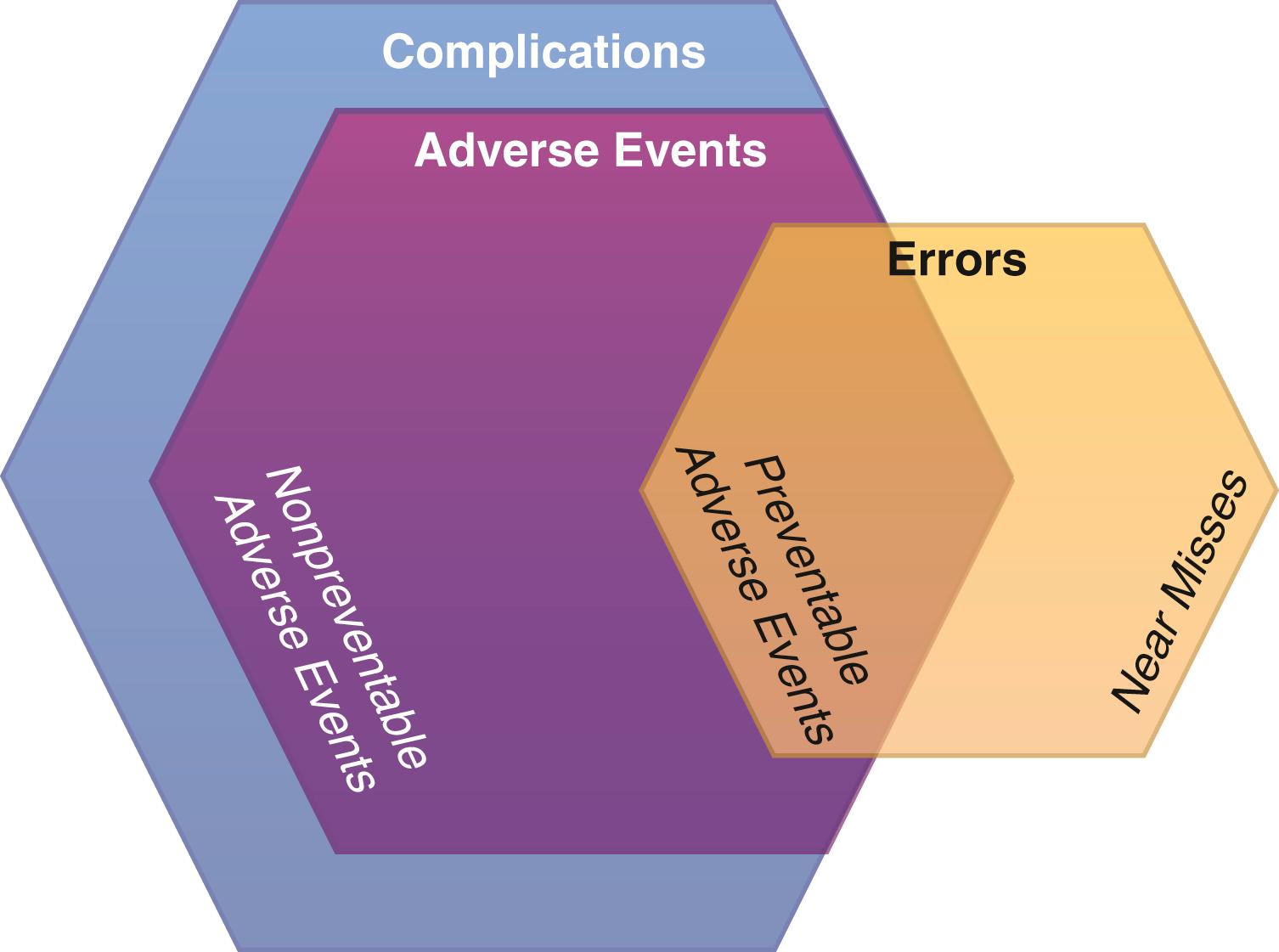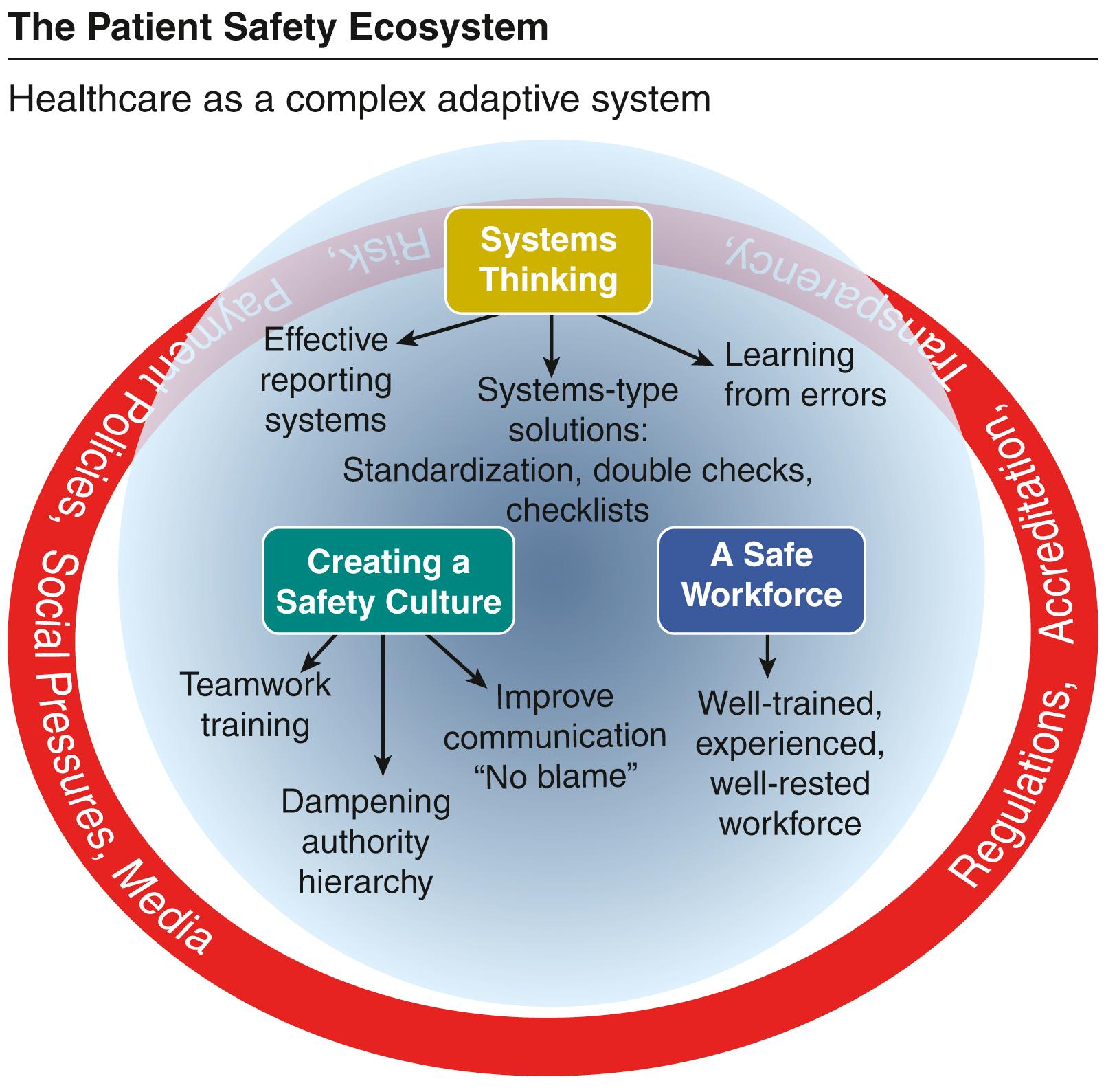Physical Address
304 North Cardinal St.
Dorchester Center, MA 02124
This chapter includes an accompanying lecture presentation that has been prepared by the authors: ![]() .
.
Medical errors have a large impact on the field of neurosurgery, affecting quality and cost tremendously.
Errors in neurosurgery can lead to preventable and nonpreventable adverse events.
A systems approach is critical to improving patient safety in neurosurgery in order to identify deficits in the system, rather than the individual neurosurgeon.
Incident reports, morbidity and mortality conferences, claims data, registries, and electronic medical record reports are all sources of data for error analysis.
Mechanisms for improving patient safety include root cause analyses that investigate systemic causes of adverse events, preoperative checklists, and postoperative debriefing to ensure adequate communication during transitions in care.
Surgical site infections are a common neurosurgical complication, and often can be prevented with antibiotic prophylaxis.
There is a well-known relationship between operative volume and positive surgical outcomes.
Physicians routinely dedicate their time, skills, and expertise to their patients, helping to prevent illness and restore health. Despite the best efforts of health care workers, however, many patients are unintentionally injured by the very medical system from which they seek help. Understanding why these injuries happen, how they happen, and how we can prevent them from happening forms the core of the patient safety movement in contemporary medicine.
The modern patient safety movement arguably coalesced in the wake of the 2000 publication of To Err Is Human (taken from Seneca’s Latin phrase errare humanum est ) by the National Academy of Medicine (formerly the Institute of Medicine). , This decidedly influential report drew on the 1991 Harvard Medical Practice Study and estimated that between 44,000 and 98,000 Americans were killed yearly by medical errors. This shockingly high figure spawned the evocative “jumbo jet” analogy—deaths caused by medical errors were numerically equivalent to one passenger jet crashing daily. More recent studies, following the Harvard Medical Practice Study, have adjusted the estimate of those killed by errors even higher, at 210,000 to 440,000.
The early report by the National Academy of Medicine stoked renewed national interest in patient safety, and a large contingent of researchers, physicians, nurses, and administrators have invested heavily in identifying and preventing such errors. Medication errors have been reduced through computerized provider order entry, an increase in clinical pharmacists, medication reconciliation, and bar-code scanning. Hospital-acquired infections have been reduced through standardized protocols for central line placement, daily “sedation vacations” to reduce ventilator-associated pneumonia, , and timely use of perioperative antibiotics to prevent surgical site infections (SSIs). , Surgical errors are reduced by time-out procedures, , instrument counts, , site marking, and other standardized procedures.
Yet the size and impact of medical errors remain vast. Medication errors are perhaps the best documented. By some estimates, 5% of all hospital admissions are due to adverse events related to medications, and at least 5% of all hospitalized patients experience at least one adverse drug event. Cost estimates place ambulatory medication errors at $5 billion yearly and inpatient errors at $16.4 billion yearly. ,
Surgical adverse events are also unfortunately common. An estimated 3% of all surgical patients experience an adverse event in the perioperative period, half of which are preventable. In neurosurgical patients specifically, 14.3% have at least one complication. Roughly 1 in every 100,000 operations involves the wrong site or wrong patient, and the wrong side is operated on in 2.2 of every 10,000 craniotomies. A recent poll of neurosurgeons revealed that 25% reported making an incision on the wrong side of the head, and 35% reported wrong-level lumbar surgery during their career. Retained instruments and sponges occur in about 1 in every 5500 to 10,000 operations. The economic cost of these errors is high. Analysis of the National Practitioner Data Bank shows $1.3 billion in settlements alone between 1990 and 2010. This does not include the 90% of patients who do not receive payments and are not included in the database. A single wrong-site surgery has an average payout of $127,159, and that for a retained foreign body is $86,247. More troubling, the number of these events appears to be increasing over time.
Infections are another source of preventable harm. As many as 1 in 10 patients will develop an iatrogenic infection, according to the Centers for Disease Control and Prevention. , Some estimates place the number of resulting deaths from iatrogenic infections at 100,000 annually, with costs of around $40 billion. ,
There are many ways in which the medical field can inadvertently harm patients. The following taxonomy was developed to categorize these types of events ( Figure 6.1 ).

Adverse events are inadvertent injuries resulting from medical care, or the failure to deliver appropriate care. The Institute for Healthcare Improvement (IHI) further defines adverse events as “unintended physical injury resulting from or contributed to by medical care (including the absence of indicated medical treatment) that requires additional monitoring, treatment, or hospitalization, or that results in death.”
Adverse events can further be split into preventable adverse events and nonpreventable adverse events. Nonpreventable adverse events include accepted surgical complications, such as the risk of hemorrhage with external ventricular drain placement, and some medication side effects, such as the increased risk of hyperglycemia with high-dose dexamethasone. Preventable adverse events, on the other hand, include harm caused by clear errors, such as wrong-side and wrong-level surgery, or failure to offer standard treatment, such as neglected deep venous thromboembolism prophylaxis in surgical patients.
Complications, a common term in surgical specialties, are less well defined but are probably best understood as including all adverse events, both preventable and nonpreventable, but also including harm directly related to the disease rather than from medical care associated with the disease. An example of a complication would include an intracranial hemorrhage associated with a brain tumor, even if it happened outside the hospital and without medical care contributing at all to its occurrence (i.e., an inevitable “complication” of the disease).
Errors are acts or omissions that lead to undesirable outcomes or have a high potential for such an outcome. Thus errors overlap with preventable adverse events but crucially include events that cause no harm (so-called near misses or close calls). That is, some errors by health care workers are detected by the health care system and prevented from injuring the patient, such as incorrectly ordered medication doses or medication cross-reactions caught by computerized provider order entry systems or clinical pharmacists.
Errors can be further broken down into active errors (or “sharp end” errors) and latent errors (or “blunt end” errors) ( Table 6.1 ). Active errors are errors that occur when the patient is in contact with health care personnel, are usually readily apparent, and almost always involve a health care worker on the front line. Latent errors refer to less apparent failures of the organization or design that allow harm to come to patients. An example is chemotherapy being infused at the wrong rate. The active error would be a nurse programming the wrong rate into the intravenous (IV) pump. A latent error would be the health care system or organization using multiple types of IV pumps, thus leading to increased nursing confusion and the increased probability of an adverse event occurring.
| Level | Examples |
|---|---|
| Governmental |
|
| Institutional |
|
| Infrastructure |
|
| Team |
|
| Individual health care worker |
|
| Individual patient |
|
Active errors have been extensively studied in psychology, and many subdivisions have been proposed to further delineate errors and identify common mechanisms. Examples are James Reason’s classification of active errors into slips and mistakes. Slips occur when an intended action is carried out imperfectly—as in literally slipping with a scalpel while operating, and damaging uninvolved tissue. Thus slips occur as a result of lapses of concentration or failures of schematic behaviors, and can happen in the face of competing distractions, fatigue, and stress. Mistakes occur when the wrong action is selected, even if carried out perfectly. Mistakes are failures of active problem solving resulting from incorrect judgment, lack of knowledge or skills, or intentional failure to adhere to common standards. A classic example is wrong-side or wrong-level surgery.
More complex divisions of errors include the classification by the National Coordinating Council (NCC) for Medication Error Reporting and Prevention, which divides errors into nine classes (A through I) determined by how much harm, if any, was caused. The NCC classification is notable, however, for dividing errors by their effects, as compared with Reason’s classification, which focuses on mechanisms.
Adverse events and medical errors are costly and common. What is the source of these errors? When prospectively analyzing errors in neurosurgical procedures, in one study only 23.7% to 27.8% were related to the technical skills of the surgeon. The remainder, roughly 75%, involved various other participants in the patient’s care—for example, nurses, anesthetists, and equipment technicians.
It is crucial for the surgeon to acknowledge that many errors arise from factors outside his or her direct control. Such observations, which abound across medical specialties, make it clear that improving patient safety requires an analysis of the entire health care system to which a patient is exposed. Thus systems thinking is critical. , Even if a surgeon performs his or her procedure perfectly, only a quarter of errors might be prevented.
Systems thinking has been advocated for patient safety since the publication of To Err Is Human. Essentially, a complex system such as medicine produces errors not only through technical mistakes and slips, but also through cultural, social, and organizational problems. All of these domains feed into one another and are interrelated ( Figure 6.2 ). Systems thinking acknowledges that all humans will make mistakes, and these mistakes will occur throughout the health care system. To prevent these inevitable errors from harming patients, the system should be robustly designed to catch these errors and mitigate their harm, which has long been the case in other industries concerned with safety, such as nuclear power and air transportation.

In order to rationally develop processes to address patient safety, two main steps are involved. First, errors and adverse events must be reliably identified and documented. Only when the problem scope is known can limited resources be directed to the most pressing areas. Second, solutions can be proposed to prevent or mitigate adverse events across the extent of the health care system (see Table 6.1 ). In line with systems thinking, these solutions are not restricted to the “sharp end” of the system—that is, surgeons and other providers directly interacting with the patient—but also can be applied at the “blunt end”—the management, regulations, facilities, and other entities that influence patient care in sometimes dangerous ways.
Become a Clinical Tree membership for Full access and enjoy Unlimited articles
If you are a member. Log in here